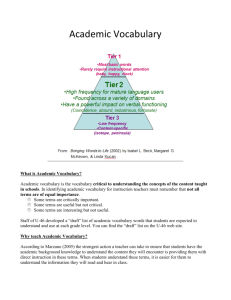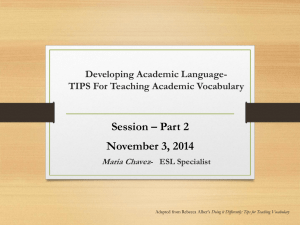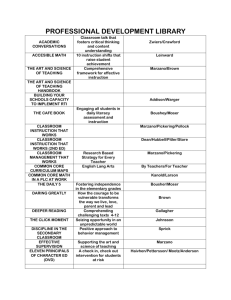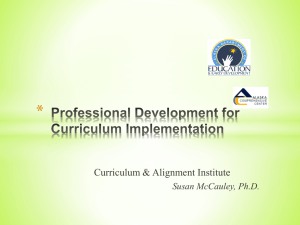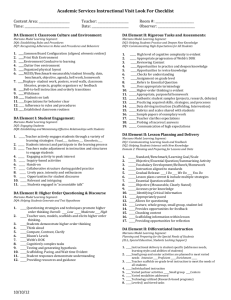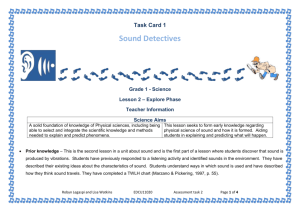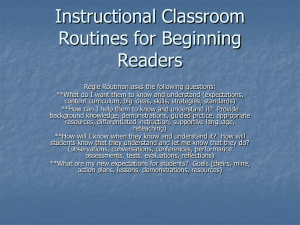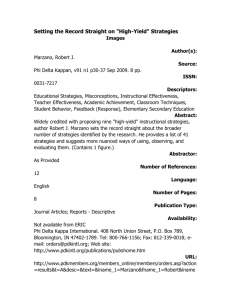Classroom Assistance Tool - Florida`s Positive Behavior Support
advertisement
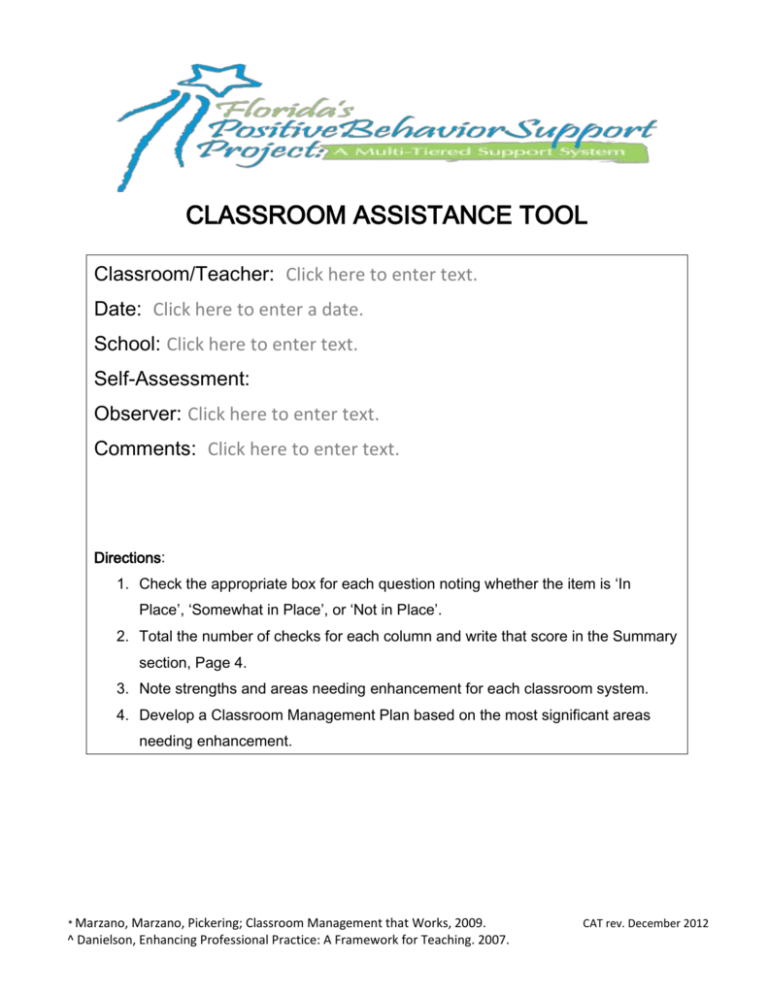
CLASSROOM ASSISTANCE TOOL Classroom/Teacher: Click here to enter text. Date: Click here to enter a date. School: Click here to enter text. Self-Assessment: Observer: Click here to enter text. Comments: Click here to enter text. Directions: 1. Check the appropriate box for each question noting whether the item is ‘In Place’, ‘Somewhat in Place’, or ‘Not in Place’. 2. Total the number of checks for each column and write that score in the Summary section, Page 4. 3. Note strengths and areas needing enhancement for each classroom system. 4. Develop a Classroom Management Plan based on the most significant areas needing enhancement. * Marzano, Marzano, Pickering; Classroom Management that Works, 2009. ^ Danielson, Enhancing Professional Practice: A Framework for Teaching. 2007. CAT rev. December 2012 1. ECOLOGICAL FACTORS: Environmental variables help prevent or decrease problem behavior. A. Physical Setting- Classroom setting is organized to promote learning and In place independence.*^ Some Not in what in place place 1. Room is arranged to minimize crowding and distractions. *^ 2. Materials are organized and easily accessible. *^ 3. Students have secure and adequate space for personal storage. ^ 4. Furniture is arranged to enhance traffic flow. *^ 5. Instructional areas have clear visual boundaries. *^ B. Scheduling- Instructional schedule optimizes student learning. In place Some Not in what in place place 1. Daily activity schedule posted and reviewed regularly. 2. Transitions & non-instructional activities posted and reviewed regularly. 3. Daily schedule provides time for independent work, 1 to 1 instruction, small and large group activities, socialization, and free time ^ 4. Students are engaged in active learning activities, with little/no unstructured downtime *^ C. Socialization- Social instruction opportunities are provided to optimize student learning. In place Some Not in what in place place 1. The development of individual responsibility and independence is emphasized for all students. *^ 2. Communication between teacher and family occurs weekly. ^ 3. Skills are taught in the setting and situation in which they naturally occur. * 4. Friendships between students are promoted. *^ 5. Effective, efficient communication strategies are taught to all students.* 6. Students with disabilities provided opportunities to interact/socialize with typical peers. * Marzano, Marzano, Pickering; Classroom Management that Works, 2009. ^ Danielson, Enhancing Professional Practice: A Framework for Teaching. 2007. CAT rev. December 2012 2. CLASSROOM BEHAVIOR SYSTEM: An effective behavior system helps increase appropriate behavior and decrease behavior problems. A. Define and Teach Behavior *^ In place Some Not in what in place place 1. Expectations and rules are clearly defined, positively stated and posted. *^ 2. Office versus Teacher-Managed behaviors are clearly defined and differentiated. 3. Expectations and rules are explicitly taught and practiced. *^ 4. Classroom behavior data is regularly collected and analyzed to guide ongoing decisions. B. Reward System * In place Some Not in what in place place 1. A recognition/reward system for appropriate behavior is in place. * 2. Specific criteria are in place for earning reinforcers and students are aware of the criteria. * 3. All students are eligible to earn reinforcers. 4. Earned rewards are never taken away, or threatened to be removed. 5. Reinforcers are age appropriate and accessible to all students. 6. Specific behavioral praise is provided at a rate of 4 positives to 1 corrective statement. C. Consequence System * In place Some Not in what in place place 1. Hierarchy of consequences for inappropriate behavior is in place. * 2. Consequences are delivered consistently, respectfully, and in a timely manner.*^ 3. Students are calmly reminded of expectations and choices. *^ 4. A communication system for communicating with families is in place and does not rely entirely on students as the messengers.* 5. Positive strategies are used to strengthen home/school partnership.* 6. Alternate strategies available for students not responding to the expectations.* * Marzano, Marzano, Pickering; Classroom Management that Works, 2009. ^ Danielson, Enhancing Professional Practice: A Framework for Teaching. 2007. CAT rev. December 2012 3. CURRICULUM AND INSTRUCTION: Effective instructional strategies and relevant curriculum help increase appropriate behavior and decrease problem behavior. A. In place Instructional Planning and Delivery- Teaching activities are planned and implemented to optimize student learning. *^ Some Not in what in place place 1. Lesson objectives and materials are matched to student levels of function. *^ 2. Assignments are relevant and meaningful to students. *^ 3. A variety of teaching methods and materials are used. *^ 4. Appropriate time is allotted for completion of assignments. *^ 5. The instructional pace meets the needs of all students. *^ 6. Frequent checks for understanding are conducted after directions are delivered and while task is being completed. *^ 7. Choices are offered within and/or across tasks. ^ 8. Specific academic praise is provided during guided and independent practice. *^ 9. Corrective feedback is provided promptly and positively during guided practice. *^ 10. Curriculum modifications and/or adaptations are made to meet student needs. *^ Summary of Classroom Setting Positive Behavior Supports Total Marked Total Somewhat Total Marked In Place In Place Not In Place 1. Ecological Factors Choose score Choose score Choose score 2. Classroom Behavior Systems Choose score Choose score Choose score 3. Curriculum and Instruction Choose score Choose score Choose score * Marzano, Marzano, Pickering; Classroom Management that Works, 2009. ^ Danielson, Enhancing Professional Practice: A Framework for Teaching. 2007. CAT rev. December 2012 Summary Analysis and Action Planning 1. 2. 1. List the strengths of each system based on Click here to enter text. items marked ‘In Place’ 2. List areas needing enhancement for each Click here to enter text. System based on items marked ‘Not in Place’ or Somewhat in Place’. 3. Identify next steps for enhancing areas of need. * Marzano, Click here to enter text. Marzano, Pickering; Classroom Management that Works, 2009. ^ Danielson, Enhancing Professional Practice: A Framework for Teaching. 2007. CAT rev. December 2012


